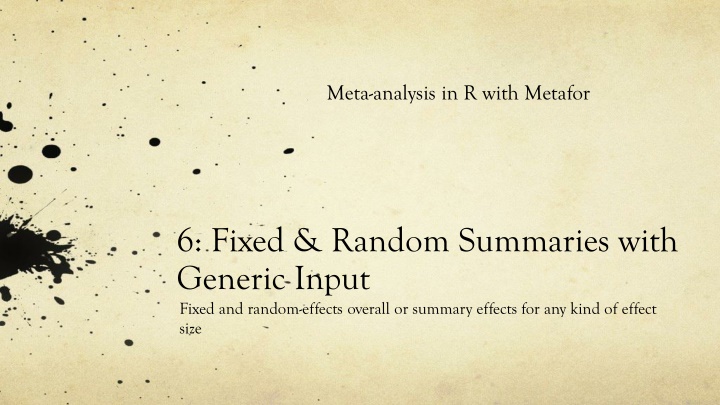
Meta-analysis in R with Metafor: Fixed & Random Summaries
Learn about conducting meta-analysis in R using the Metafor package for fixed and random effect summaries. Explore options for combining study effect sizes, choosing between fixed and random effects analyses, methods for estimating random effects variance, and transforming input effect sizes. Dive into examples, R code snippets, and considerations for selecting the appropriate method.
Download Presentation

Please find below an Image/Link to download the presentation.
The content on the website is provided AS IS for your information and personal use only. It may not be sold, licensed, or shared on other websites without obtaining consent from the author. If you encounter any issues during the download, it is possible that the publisher has removed the file from their server.
You are allowed to download the files provided on this website for personal or commercial use, subject to the condition that they are used lawfully. All files are the property of their respective owners.
The content on the website is provided AS IS for your information and personal use only. It may not be sold, licensed, or shared on other websites without obtaining consent from the author.
E N D
Presentation Transcript
Meta-analysis in R with Metafor 6: Fixed & Random Summaries with Generic Input Fixed and random-effects overall or summary effects for any kind of effect size
Overall Summary The Metafor program uses inverse variance weights to combine study ES into an overall or summary effect size You can specify Fixed (common) effects analysis or Random (varying) effects analysis If RE, you can choose from several methods for estimating the random effects variance component (REVC). Different REVC, weight, summary. Themethodstatement specifies both fixed or random and which REVC estimator you want The effect sizes input to metafor may be transformed in various ways Themeasureoption tells metafor what transformation you want
Simplest Example The default model is a generic, random effects analysis using a restricted maximum likelihood algorithm to estimate the REVC You just input yi (the effect size for each study), vi (sampling variance for each study), and the name of the dataset. Note that to Metafor, yi means generic ES and vi means generic variance. You can choose any names you like for the input variables (e.g., yi= d, yi=Di, yi=gymsocks; whatever you named it in your Excel sheet). Metafor computes the overall summary. You tell R to print the result.
R code: McNatt McNatt DB: Ancient Pygmalion joins contemporary management: A meta-analysis of the result. Journal of Applied Psychology 2000, 85:314-322. Example of running a generic effect size and variance
Choice of Method For fixed effects: method= FE The choices for random effects (estimators of REVC), method = : HS - Hunter & Schmidt HE Hedges DL DerSimonian-Laird SJ Sidik-Jonkman ML Maximum likelihood REML Restricted maximum likelihood EB Empirical Bayes
R code: McNatt RE with DerSimonian-Laird estimator Fixed Effects
Generic Input and Measure= If you use generic input, you compute the transformation you want (if any) and tell Metafor to use that effect size as yi. Metafor does not know or care what kind of effect size you pick. You must be sure that the variance input (vi) matches the effect size (yi) that you input. Don t input the log odds as the effect along with the variance of the odds ratio; both yi and vi must be either log or not log. If you use generic input, you must transform to another metric after the analysis if you want a different scale. For example, if you input data coded as Fisher s z to yi, the results will be in z, and you will have to convert back to r if that is what you want to present. Or if you input log(odds ratio) to yi, then the analysis will be done in log odds, and you must convert back to odds if that is what you want to report. If you use preferred formats for mean difference, correlations, or binary studies, you can instruct Metafor with the measure= command to make a transformation. This is discussed in the next two videos.
